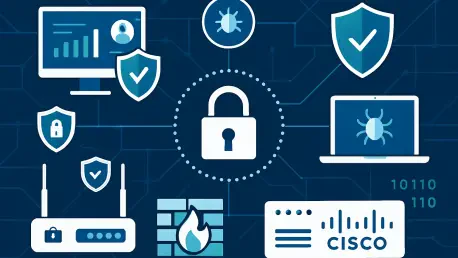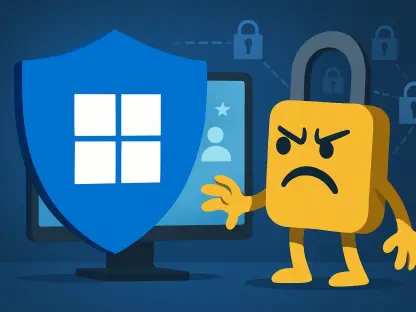Imagine a vast network of critical infrastructure—hospitals, financial institutions, and government systems—suddenly grinding to a halt due to an unseen flaw in the very software that connects them, turning a hypothetical concern into a pressing reality. The discovery of a severe zero-day vulnerability in Cisco IOS and IOS XE Software, identified as CVE-2025-20352, with a severity score of 7.7 out of 10, has already been exploited in real-world scenarios, underscoring the fragility of even the most trusted networking solutions. The stakes are high, as this vulnerability threatens to disrupt operations or grant attackers full control over affected systems.
This critical issue, rooted in the Simple Network Management Protocol (SNMP) subsystem, has sent shockwaves through the cybersecurity community. As Cisco races to mitigate the risk, organizations worldwide are left grappling with the urgent need to protect their networks. This review delves into the technical intricacies of the vulnerability, evaluates Cisco’s response, and explores the broader implications for network security in an era of escalating cyber threats.
Technical Analysis of the Vulnerability
Dissecting the SNMP Subsystem Flaw
At the heart of CVE-2025-20352 lies a stack overflow condition within the SNMP subsystem of Cisco IOS and IOS XE Software. Attackers can exploit this flaw by sending carefully crafted SNMP packets over IPv4 or IPv6, triggering a system overload. This technical weakness exposes a significant gap in the software’s ability to handle malformed input, making it a prime target for malicious actors seeking to disrupt or infiltrate networks.
The severity of this issue cannot be overstated, as it affects a wide range of devices running vulnerable software versions. Unlike typical bugs that might require complex conditions for exploitation, this flaw can be activated with relative ease if an attacker possesses the right credentials or access level. Such accessibility amplifies the potential for widespread damage across industries reliant on Cisco’s networking solutions.
Exploitation Risks by Privilege Level
The impact of this vulnerability varies dramatically based on the attacker’s privilege level. For those with low-level access, such as read-only credentials under SNMPv2c or earlier, exploitation can lead to a Denial of Service (DoS) condition. This forces the affected device to reload, disrupting network operations and potentially causing significant downtime for critical systems.
However, the danger escalates when high-privileged attackers, equipped with administrative or privilege level 15 credentials alongside SNMP access, exploit the flaw. In such cases, they can execute arbitrary code as the root user, gaining complete control over the compromised device. This level of access opens the door to data theft, system manipulation, or even the use of the device as a launchpad for further attacks within the network.
Cisco’s Response and Mitigation Strategy
Swift Action Amid Active Exploitation
In response to the active exploitation of CVE-2025-20352, Cisco issued a critical security advisory and released a patch to address the vulnerability. The company’s urgency reflects the severity of the threat, with reports from the Cisco Product Security Incident Response Team confirming real-world attacks. Immediate patching has been strongly recommended to prevent further incidents and safeguard affected systems.
Despite the prompt release of a fix, the absence of comprehensive workarounds poses a challenge for users unable to apply updates right away. Cisco has outlined temporary mitigation steps to reduce exposure, though these are not a substitute for the patch. This situation highlights the critical need for organizations to prioritize rapid deployment of security updates in the face of active threats.
Scope of Affected Devices
The vulnerability impacts a broad array of Cisco devices, including specific models like the Meraki MS390 and Cisco Catalyst 9300 Series Switches running vulnerable software versions. These devices are often integral to enterprise and industrial networks, amplifying the potential consequences of exploitation. From small businesses to large-scale infrastructure providers, the reach of this flaw is extensive.
Real-world risks include not only network disruptions but also full system compromise, especially in scenarios where local administrator credentials have been exposed. Such incidents could lead to cascading failures across interconnected systems, affecting everything from data integrity to operational continuity in sectors like healthcare and finance.
Challenges and Industry Implications
Navigating the Zero-Day Threat Landscape
Zero-day vulnerabilities like CVE-2025-20352 expose the inherent difficulties in securing complex networking software. Protocols such as SNMP, particularly older versions like v1 and v2c, have long-standing weaknesses that attackers continue to exploit. This incident serves as a stark reminder of the persistent gaps in legacy systems that remain in use despite known risks.
Beyond technical flaws, logistical hurdles compound the challenge of addressing such threats. Large organizations often face delays in patch deployment due to testing requirements, compatibility concerns, or the sheer scale of their infrastructure. These delays create windows of opportunity for attackers, emphasizing the need for streamlined update processes and robust interim defenses.
Long-Term Security Concerns
The broader industry must confront the reality that sophisticated attacks leveraging privileged access are becoming more common. Protecting critical systems requires not only reactive measures like patches but also proactive strategies to minimize attack surfaces. Phasing out outdated protocols and enhancing credential security are steps toward reducing the likelihood of similar vulnerabilities emerging in the future.
Reflecting on Lessons Learned and Next Steps
Looking back, the emergence of CVE-2025-20352 revealed critical vulnerabilities in Cisco’s widely used IOS and IOS XE Software, with exploitation leading to both service disruptions and potential system takeovers. Cisco’s rapid response with a patch was commendable, though the lack of full workarounds underscored the urgency of update deployment. The varying impact based on attacker privilege levels highlighted how access control remains a pivotal factor in network security.
Moving forward, organizations must prioritize not only the immediate application of patches but also the adoption of enhanced monitoring to detect unusual activity indicative of exploitation attempts. Strengthening access policies to limit high-privilege credentials can serve as a vital barrier against severe outcomes. Additionally, the industry should accelerate efforts to modernize protocols and invest in predictive threat detection to stay ahead of zero-day risks.
As network security continues to evolve, collaboration between vendors like Cisco and their user base will be essential to fortify defenses. Exploring automated patch management solutions and integrating advanced anomaly detection tools could provide a buffer against future threats. Ultimately, this incident served as a catalyst for rethinking how critical infrastructure is safeguarded in an increasingly hostile digital landscape.









